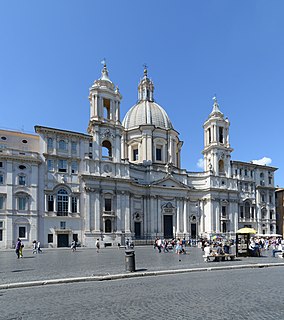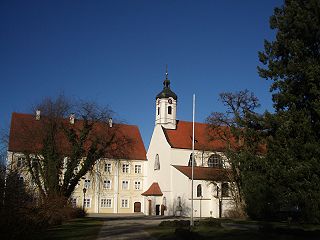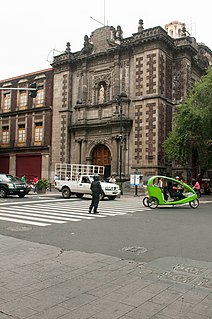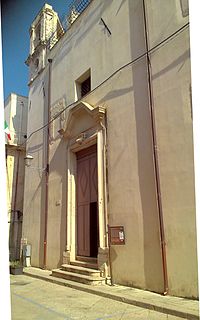
Francesco Borromini, byname of Francesco Castelli, was an Italian architect born in the modern Swiss canton of Ticino who, with his contemporaries Gian Lorenzo Bernini and Pietro da Cortona, was a leading figure in the emergence of Roman Baroque architecture.
Jan Blažej Santini Aichel was a Czech architect of Italian descent, whose major works represent the unique Baroque Gothic style - the special combination of the Baroque and Gothic styles.

Baroque architecture is a highly decorative and theatrical style which appeared in Italy in the early 17th century and gradually spread across Europe. It was originally introduced by the Catholic Church, particularly by the Jesuits, as a means to combat the Reformation and the Protestant church with a new architecture that inspired surprise and awe. It reached its peak in the High Baroque (1625–1675), when it was used in churches and palaces in Italy, Spain, Portugal, France, Bavaria and Austria. In the Late Baroque period (1675–1750), it reached as far as Russia and the Spanish and Portuguese colonies in Latin America. About 1730, an even more elaborately decorative variant called Rococo appeared and flourished in Central Europe.

The church of San Carlo alle Quattro Fontane, also called San Carlino, is a Roman Catholic church in Rome, Italy. The church was designed by the architect Francesco Borromini and it was his first independent commission. It is an iconic masterpiece of Baroque architecture, built as part of a complex of monastic buildings on the Quirinal Hill for the Spanish Trinitarians, an order dedicated to the freeing of Christian slaves. He received the commission in 1634, under the patronage of Cardinal Francesco Barberini, whose palace was across the road. However, this financial backing did not last and subsequently the building project suffered various financial difficulties. It is one of at least three churches in Rome dedicated to San Carlo, including San Carlo ai Catinari and San Carlo al Corso.

Sant'Agnese in Agone is a 17th-century Baroque church in Rome, Italy. It faces onto the Piazza Navona, one of the main urban spaces in the historic centre of the city and the site where the Early Christian Saint Agnes was martyred in the ancient Stadium of Domitian. Construction began in 1652 under the architects Girolamo Rainaldi and his son Carlo Rainaldi. After numerous quarrels, the other main architect involved was Francesco Borromini.

Gutenzell Abbey was a Cistercian nunnery in the municipality of Gutenzell-Hürbel in the district of Biberach, Baden-Württemberg, Germany.

The Via Giulia is a street of historical and architectural importance in Rome, Italy, which runs along the left (east) bank of the Tiber from Piazza San Vincenzo Pallotti, near Ponte Sisto, to Piazza dell'Oro. It is about 1 kilometre long and connects the Regola and Ponte Rioni.

The Basilica of San Giovanni dei Fiorentini is a minor basilica and a titular church in the Ponte rione of Rome, Italy.

Valmontone is a comune (municipality) in the Metropolitan City of Rome in the Italian region Lazio, located about 45 kilometres southeast of Rome.

The Church of San Bernardo stands at the corner of Avenida 20 de Noviembre and Venustiano Carranza Street just south of the Zocalo or main plaza of Mexico City. It was part of a convent of the same name that was founded in 1636, but was closed along with all convents and monasteries during the La Reforma period in 1861. Currently, only the church remains of the convent complex.

The Church of Saint Lucy in Selci is an ancient Roman Catholic church, located in Rome, dedicated to Saint Lucy, a 4th-century virgin and martyr.

San Giuseppe dei Ruffi or church of San Giuseppe dei Ruffo is a church located on piazzetta San Giuseppe dei Ruffi, in Naples, Italy.

Santa Maria dei Miracoli is a basilica church located in the largo dei Miracoli, near Via Foria in the city center of Naples, Italy. The neighborhood is named that of Miracoli or Miracles.

San Bernardino da Siena and the adjacent Capuchin order Monastery are a Roman Catholic, Baroque style church and convent respectively, located on Via Trento Trieste 20 in central Carpi, Emilia-Romagna, Italy. San Bernardino da Siena is the patron saint of Carpi.
The Church of Benedictines and its attached convent are a Baroque style, Roman Catholic temple and monastery, located in central Piacenza, region of Emilia Romagna, Italy.

The Abbey of the Holy Spirit at Morrone, known by various titles, is a former monastery some five kilometers outside of the town of Sulmona, at the base of Monte Morrone, in the Province of L'Aquila, region of Abruzzo, Italy.

Santa Maria della Carità or just known as the Carità, or the church of the Buon Pastore, is a Baroque-style, Roman Catholic church located on Via dei Musei corner via Rosa in Brescia, region of Lombardy, Italy.

Santi Cosma e Damiano is a Roman Catholic church in Alcamo, in the province of Trapani, Sicily, southern Italy.
The Monastery of San Giuseppe is a Roman Catholic cloistered female convent located in Via Regina Margherita #8 at the town limits of Mogliano, province of Macerata, in the region of Marche, Italy.

Santa Chiara all'Albergaria refers to a church and former monastery located in piazza Santa Chiara, in the quarter of Albergaria in the city of Palermo, region of Sicily, Italy. The church is located near the busy outdoor Ballarò marketplace.


















